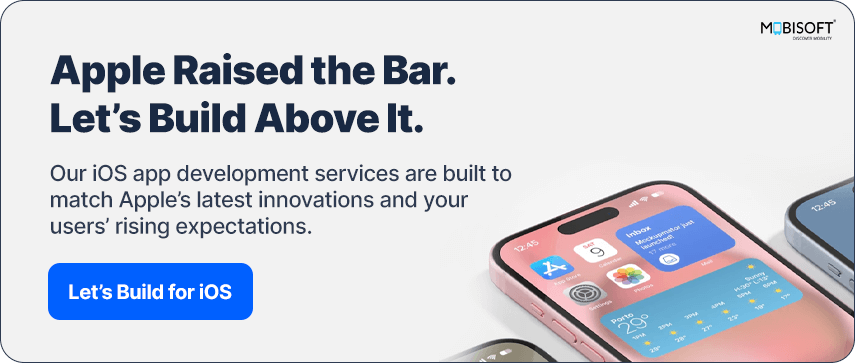Apple WWDC 2025 delivered a fresh wave of innovation that developers and businesses cannot ignore.
The company rolled out a bold new design called Apple Liquid Glass Design and switched to a clearer, year-based naming system for its operating systems. From iOS to macOS, and visionOS to watchOS, the new Apple iOS updates 2025 bring practical changes and new tools.
With these updates, iOS app development teams now have a more unified and capable platform to build next-gen apps.
Apple Intelligence was also expanded, with on device AI now available to developers, signaling a shift in how apps will work going forward. While Siri AI upgrade was noticeably absent, the rest of the ecosystem saw meaningful upgrades. Here’s everything you need to know from this year’s event.

Apple WWDC 2025 Key Highlights
- Introducing Liquid Glass: A Unified Design Across Platforms
- Simplified Version Naming: Year Based OS Versions
- Expanded On-Device Apple Intelligence for Developers
- iOS 26 features: Revamped Core Apps and Power Management
- iPadOS 26: Bringing Desktop Multitasking to iPad
- macOS Tahoe 26: Enhanced Spotlight and New Applications
- watchOS 26: AI-Driven Workouts and Gesture Controls
- visionOS 26 and tvOS 26: Expanding Immersive and Media Experiences
- Siri’s Absence and Apple’s AI Expansion Approach
Let’s explore in detail.
Introducing Liquid Glass: A Unified Design Across Platforms

Apple introduced the apple liquid glass design, a translucent and adaptive design language. This new aesthetic flows across all Apple platforms, including iPhone, iPad, Mac, Apple Watch, Apple TV, and Vision Pro. It adds glass-like transparency that adapts based on content and user interaction.
This design aims to deliver a consistent and modern user experience. The visuals balance clarity and depth, helping users focus on their tasks. This fresh look also unifies Apple’s software ecosystem visually.
Simplified Version Naming: Year-Based OS Versions
Apple changed the way it names its operating systems. Instead of sequential version numbers, Apple now uses the calendar year. For example, the latest releases are labeled iOS 26, macOS Tahoe 26, watchOS 26, visionOS 26, and so on.
This change helps users and developers track updates more intuitively. It also aligns Apple’s software cycle with the calendar year, simplifying version recognition.
Expanded On-Device Apple Intelligence for Developers

At Apple WWDC 2025, the company introduced the foundation models framework. It allows third party developers to build applications powered by artificial intelligence running entirely on device. These models operate offline, preserving user privacy.
Developers can now create smarter apps that analyze text, images, and more without sending data to the cloud. Apple also integrated ChatGPT technology into its new Image Playground feature, opening creative AI-powered tools to users.
Apple on Defense: External Challenges and AI Strategy
WWDC 2025 took place amid external pressures on Apple. The company recently faced legal scrutiny over its App Store policies and ongoing trade tensions affecting its supply chain. In this environment, Apple’s AI expansion was handled cautiously.
Notably, Siri AI upgrade 2025 did not materialize. Apple emphasized quality and plans to revisit Siri’s development next year. This reflects a careful strategy in a competitive AI landscape dominated by faster-moving rivals.
iOS 26: Revamped Core Apps and Power Management
iOS 26 features include noticeable improvements to core apps. The Camera app received a redesign, improving ease of use. Safari now offers faster performance and enhanced tab management.
The Phone app combines favorites, recent calls, and the keypad into a single, streamlined view. This redesign aligns with the direction highlighted in the Apple WWDC 2025 summary, aiming to improve user navigation.
Apple added an adaptive power mode that optimizes battery usage based on user habits. New battery comparison tools in Settings help users monitor battery health over time.
Messages in iOS 26 get new features like chat backgrounds, polling options, and enhanced message filtering to manage conversations better.
iPadOS 26: Bringing Desktop Multitasking to iPad
iPadOS 26 adds desktop-style multitasking features. Users can open apps in resizable windows, similar to macOS. A new traditional menu bar improves app navigation and access to controls.
The pointer support feels more Mac-like, with improved precision. Apple also introduced the Preview app for iPad, bringing document viewing and editing capabilities similar to macOS. This evolution reflects Apple’s commitment to productivity and thoughtful UI/UX design that bridges the experience across devices.
These changes make iPadOS 26 more productive and closer to a full desktop experience.
macOS Tahoe 26: Enhanced Spotlight and New Applications
macOS tahoe 26 adopts the Liquid Glass design for a sleek appearance. Spotlight search gains smart filters and actionable results, letting users find information faster.
The update includes a new Games app to connect with friends and a Phone app to make calls directly from Mac.
Apple discontinued support for some older Intel Macs, including the 2017 iMac Pro. Developers should note these compatibility changes when planning software updates related to the macOS Tahoe update and other new Apple OS updates 2025.
watchOS 26: AI-Driven Workouts and Gesture Controls
watchOS 26 introduces an AI-powered Workout Buddy. It offers personalized coaching and feedback to improve fitness routines.
A new wrist flick gesture lets users dismiss notifications quickly without touching the screen. This gesture aims to improve interaction, especially during workouts or busy moments.
visionOS 26 and tvOS 26: Expanding Immersive and Media Experiences
visionOS 26 for the Vision Pro headset adds support for PSVR2 controllers, expanding gaming options in spatial computing.
Spatial widgets enhance user customization of the Vision Pro’s home environment, creating more interactive and personalized experiences.
tvOS 26 adopts the Liquid Glass design and improves profile management. FaceTime gains new features, improving video calls on Apple TV.
Siri’s Absence and Apple’s AI Approach
Notably, Siri received no major updates at WWDC 2025. Apple cited quality standards as the reason to delay significant Siri enhancements until 2026.
While Apple expanded AI capabilities in many areas, it remains cautious with its voice assistant. This contrasts with other companies pushing aggressive AI deployments.
The Siri AI upgrade 2025 was expected but will now roll out next year, underscoring Apple’s careful AI expansion strategy.
A Moment Interrupted: The Protester at WWDC
An unexpected moment occurred when a protester briefly interrupted Apple executive Craig Federighi during his keynote. Security quickly handled the situation without disrupting the event. This incident highlights the heightened scrutiny Apple currently faces, but it did not affect the conference flow or announcements.
Conclusion
WWDC 2025 highlights Apple’s focus on design consistency, privacy-preserving AI, and improved user productivity. The Apple Liquid Glass design creates a cohesive experience across devices. Developers gain new AI tools for on-device Apple intelligence. Users will enjoy smarter apps and better multitasking.
Brands looking to build cutting-edge apps can hire iOS app developers with the skills to leverage these advancements.
We will continue to monitor Apple’s announcements and share updates here as new information becomes available. Stay tuned to this blog for the latest insights on Apple’s evolving ecosystem.





 June 11, 2025
June 11, 2025


